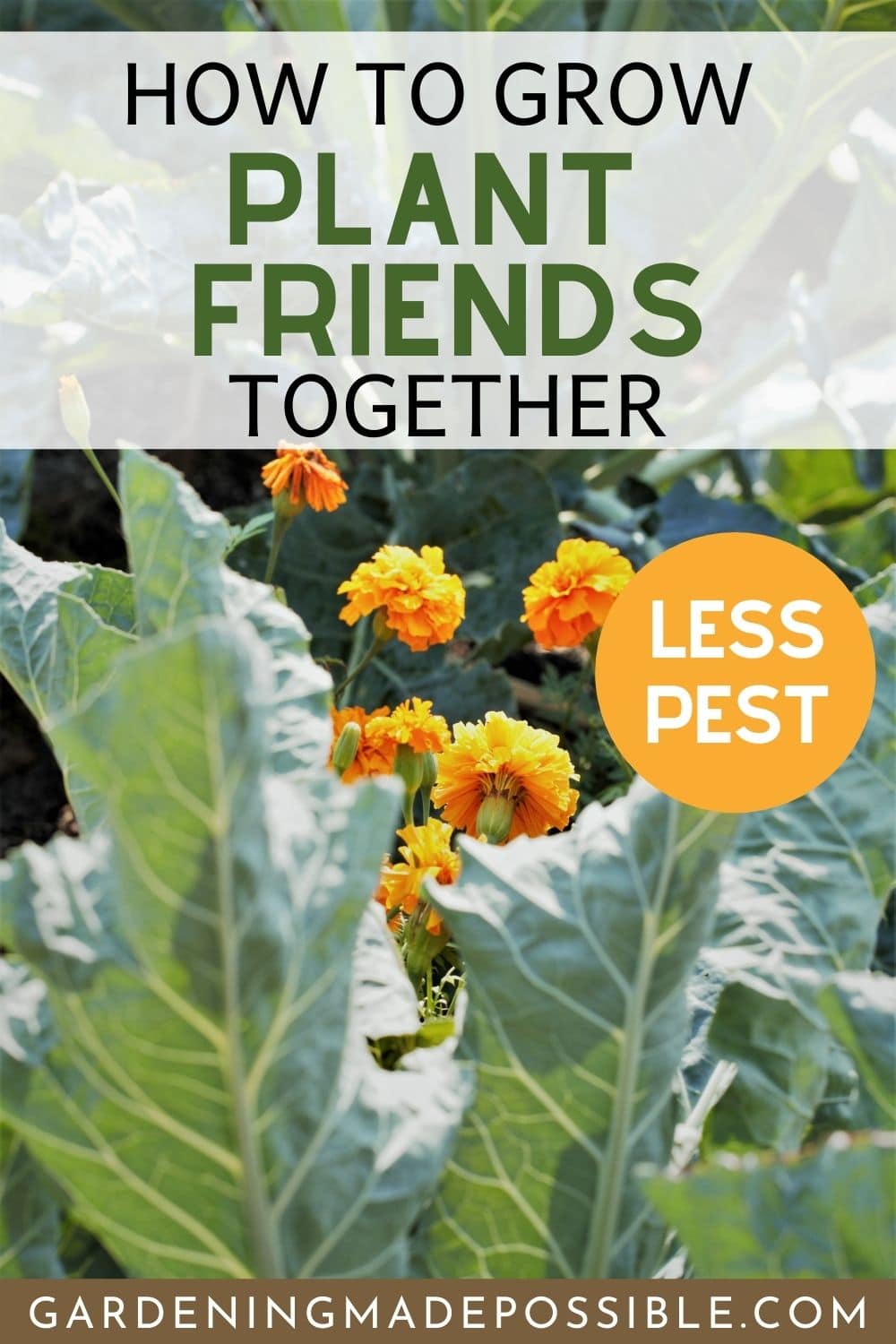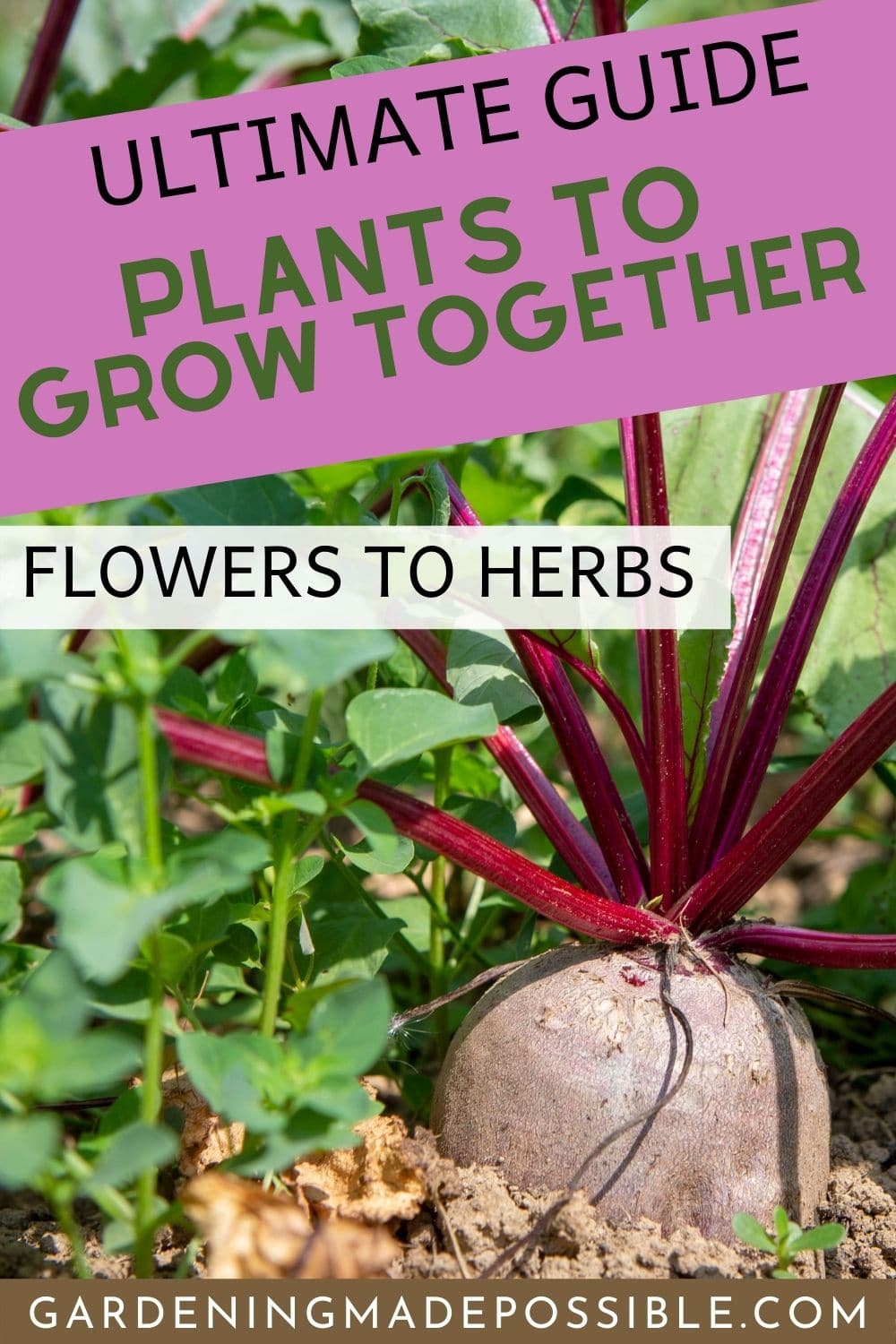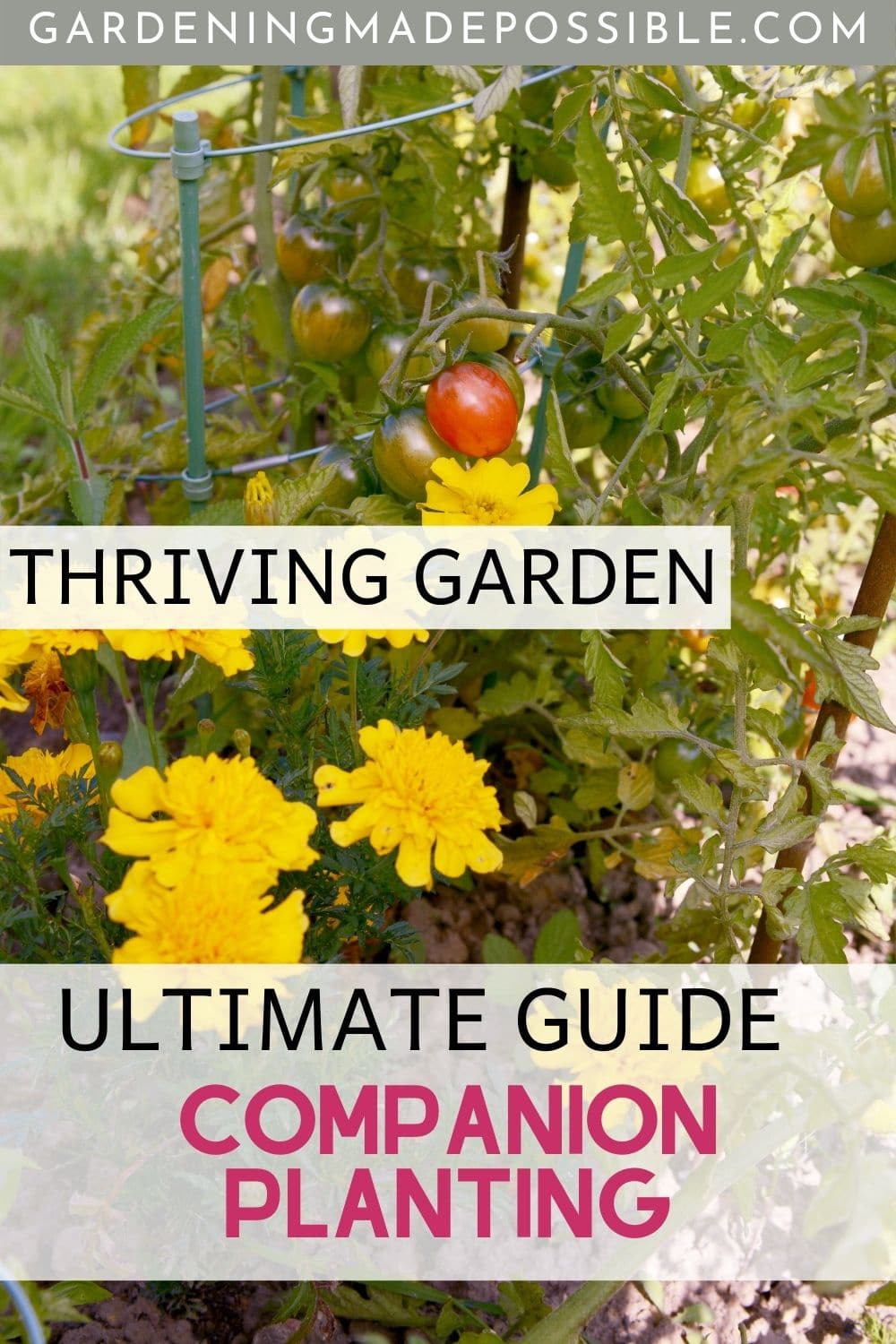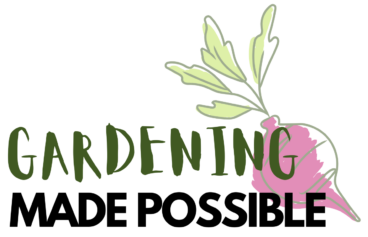Gardeners swear by the fact that plants thrive better with neighbors and friends. It is important to ensure that a mixed culture can help the plants thrive better. But there are also plant neighbors who don’t get along well and shouldn’t be planted in the immediate vicinity.
Companion Planting is a gardening method in which you plant different plants together to not only encourage growth but also aid in pest control.
Here I would like to give you a helpful overview of which plants go well together, which you can plant together, among other things. Proper planting can control pests and even maximize harvests.
Such an overview is particularly helpful for beginners. This has helped me with my garden planning, where to plant and maybe it will help you too. It is not at all too complicated to make the right selection, you have to pay attention to a few factors, such as the nutritional requirements of the individual plants, we don’t want the plants to fight about the same nutrient, but also the smell and appearance of one Plant play a role.
You will likely find some articles on companion plants. Here I would like to give you the overview that helped me as a beginner.
You can of course also try it out here and learn through experience.
On the one hand, I’ll show you which flowers look good in your vegetable patch, which herbs go well with which vegetables and which types of vegetables you can plant together.
If you plant different vegetable and herb plants together, you have a very good opportunity to have a healthy garden without resorting to chemicals.
You can use certain plants as natural insect repellants. So, you can use sage, rosemary, basil, and even horseradish instead of pesticides.
As we all know, bees and other pollinators are important to get a large harvest. Use lemon balm and borage to attract bees into the garden, which help pollinate the plants.
But here it is also important to know which plants harmonize well with each other and which cannot stand each other. And I want to help you here.
I have created an overview myself so that I can refer to it again and again in my planning, and I would now like to pass this overview on to you.

As an Amazon Associate, I earn from qualifying purchases. This post may contain affiliate links. Read More
To give a few tips, for example if you want to grow lettuce in a hot summer, I recommend growing these with plants that provide shade or heat-loving plants such as corn. So your lettuce will grow in the shade and the sun-loving plants will get the sun off.
For example, sunflowers can help to protect plants from the cabbage family from the sun and cucumbers or peas can, for example, climb the stems of the sunflower.
Hedges, for example, can serve as wind protection, especially in areas where it is very windy.
What is companion planting?
This gardening method involves planting certain plants together. The goal is to achieve higher yields, better taste, fewer diseases and fewer pests.
So you can run a garden completely organically without resorting to fertilizers and pesticides.
You can also attract beneficial insects like predatory insects, parasitic wasps that feed on pests. Wasps eat hornworms, for example. Pumpkin bugs, aphids and other pests can also be on the menu of certain insects.
The companion plants also attract pollinators and we know that you can only get a large harvest with pollinators.
Reasons for accompanying plants:
Soil change
Planting together can also change the soil. Different plants can add or remove certain elements here.
Root vegetables loosen the soil so that shallow roots can absorb more nutrients.
If you plant ground cover plants now, they can serve as mulch and prevent the soil from drying out.
Legumes like beans and peas help with nitrogen supply and make it more readily available.
Defense against garden pests
Onions and garlic help repel garden pests thanks to their strong odor. The insect’s sense of smell becomes confused and so the insect, the actual host plant, can no longer easily find it.
On the one hand, some companion plants can hide the smell of the host plant and other companions are harmful to the insects and thus do not come close enough to the host plant.
Time and space savings
For example, if you plant basil with a tomato, you can save space and time. So you can determine
put together the plants without competing for the same nutrients.
For example, you can add spinach and salads to tomatoes and parika. The spinach and lettuce serve as a mulch and protect the soil from being squeezed out. And the peppers and tomatoes can provide shade.
Flowers as companion plants
Not only herbs and other vegetable plants are suitable as companion plants, you can also plant flowers in your vegetable garden and benefit from positive results.
Pay attention to:
Use of annual flowers:
Many vegetables are annual and the same plants are not planted in the same place or pot year after year. With annual plants, you have the opportunity to rely on exactly the right plant.
Distribute the flowers:
Don’t put all of the flowers in one place. For example, you can plant marigolds, borage with tomatoes and / or peppers.
This will not only make your vegetable garden colorful, but also get some advantages from the most varied of flowers.
Taking into account the size and location
Here you should also pay attention to the location, how much sun do you have and the space. Make sure that the flowers do not interfere with your vegetables, for example providing shade.
Now let’s look at a few popular flowers that gardeners like to use as companion plants.

9 best flowers as companion plants
Comfrey
Comfrey is one of the medicinal herbs. This herb can serve as a good mulch for some vegetables and supports leaf growth with nitrogen, phosphorus, and potassium.
Comfrey goes well with: Spinach, Swiss chard, potatoes, tomatoes, peppers.
For example, you can bury comfrey leaves in the ground before the potatoes set, so that growth is supported.
Marigolds
Marigolds repel insects such as cabbage caterpillars, cucumber beetles, tomato hawks and aphids. It is advisable to put marigolds nearby.
Harmonizes well with: potatoes, asparagus, tomatoes, cabbage.
Nasturtiums
The cress is ideal for setting with your pumpkin plants or cucumber. This will keep the pumpkin bugs, Colorado potato beetles and other beetles away and aphids don’t like it either.
With the cress you can eat leaves as well as flowers. Which works great in salads.
sage
Put blooming sage like Pink Sunday or Blue Monday sage in your bed. They have absolutely beautiful flowers and bees love them. Pay attention to an annual sage, so that you can make the beetroot carefree in winter.
You can plant the sage with eggplants and peppers to keep the flea beetles away. In Brassica (cabbage) plants, it helps against the cabbage butterfly, carrots from the carrot fly.
Sage makes great companions for brassicas, carrots, beans, and potatoes.
However, do not plant sage with cucumber, onion, and garlic.
Lemon balm
Popular with bees and butterflies, lemon balm attracts pollinators. Here I recommend you either put the lemon balm on the edge of the garden, as it will sow and grow large. Or you put them in your own pot.
chamomile
Do you like to drink chamomile tea? Chamomile is not only a great medicinal herb, it also looks great in your garden.
The chamomile attracts predatory and beneficial insects and repels pests.
Chamomile goes very well with garlic and onion. The German chamomile is an annual plant and the Roman chamomile is a perennial. You should take this into account in your garden planning.
Geraniums
The geranium is a perennial plant in climate zones 10-11, in colder zones it is an annual. Depends on where you live if it is a annual or perennial plant.
You can grow geraniums as border flowers in the vegetable garden. Geraniums ward off pests such as the Japanese beetle, earwig or cabbage worm.
Cosmos flowers
The cosmos flowers are beautiful colorful flowers that are great as annual flowers. They attract pollinators and other beneficial insects.
Zinnias
Zinnias are also colorful and offer themselves as a mixed bed with cosmos flowers. These also attract pollinators and other beneficial insects. They also repel Japanese beetles.
lavender
Lavender is not only a great medicinal plant, it can also repel insects and attract pollinators.
This makes the lavender a great companion for brassicas (cabbage plants). Did you know that lavender repels mosquitos? A must if you want to sit undisturbed in your garden.
Best vegetables for Companion Planting
Let’s now take a look at which vegetables are suitable as permaculture.
horseradish
You can plant the horseradish next to potatoes, cabbage, mint, parsley and lavender. I recommend that you put the horseradish in a pot, otherwise it will spread all over your bed.
celery
Cauliflower and celery go well together. The celery helps repel the cabbage butterfly.
cucumber
Corn and cucumber are two great neighbors. The cucumbers will keep the raccoons away from your corn, and the corn will help reduce the wilting of the cucumbers. “Normal” Cucumber, English Cucumber, Plickling Cucumber
radish
Radishes planted with your cucumbers, melons, and pumpkin will help keep the cucumber beetles away.
Beans
Add the beans to your eggplant; the bean will help repel the Colorado beetle.
Corn
You can add the corn to beans, cucumber, pumpkin, potatoes and peas.
In the USA, corn beans and pumpkin are often put together. The pumpkin serves as a ground cover and pest controller. The beans in turn supply the soil with nitrogen, which promotes the growth of the corn. The corn, in turn, acts as a grid for the beans to grow.
tomatoes
Tomatoes are very versatile neighbors.
You can put tomatoes and the following plants together: basil, chives, parsley, carrot, cucumber, onion, garlic, celery, asparagus
However, you shouldn’t put tomatoes near broccoli, fennel, cabbage, corn, eggplant, peppers, dill, and potatoes.
For example, you can add the tomato to the asparagus without damaging the asparagus plant. This is how you keep the asparagus beetle away.
garlic
Garlic in tomatoes helps against red spider mites.
You can also add the garlic to brassicas, celery, lettuce, potatoes.
Garlic is a great pesticide.
Lettuce
You can add lettuce to root vegetables, carrots, cabbage, cucumber, dill, garlic, onions, radishes, spinach, pumpkin and strawberries, for example.
In principle, you can put salad anywhere. For example, you can take advantage of gaps in your garden. And have a bigger harvest. I haven’t read anywhere that there are plants that don’t get along with lettuce.
Lettuce is a shallow root and therefore goes very well with root veggies like carrots. Garlic, in turn, protects your lettuce from aphids.
Herbs as companion plants
basil
Tomatoes and basil go very well together. It doesn’t just fight insects and mosquitoes. It is also said to improve the taste and growth of tomatoes.
parsley
Adding the parsley to your carrots can keep the carrot fly away.
The parsley grows two years before it is sown.
Parsley also attracts caterpillars, which feed on aphids, and, like basil, can improve the taste of some plants.
Add your parsley to peppers, potatoes, tomatoes, carrots, corn and onions.
oregano
You can top the oregano with broccoli to ward off the cabbage butterfly.
Not only does it fight pests, it also attracts beneficial insects.
You can add oregano to almost anything.
thyme
Add the thyme to cabbage, broccoli, kale, and other types of cabbage. Thyme is good at keeping the cabbage worm away.
It can improve the taste of vegetables and attract predatory insects. Thyme, for example, repels moths.
Like the other herbs, you can add thyme to almost anything, especially cabbage and strawberries.
mint
Put the mint in a pot rather than your garden bed, as the mint grows and spreads very invasively. Mint also attracts beneficial insects and repels pests.
The mint goes very well with cabbage, onions, carrots and tomatoes.
Borage
Tired of being afflicted by tomato worms and cutworms? Borage repels tomato hornworms and improves the taste.
You can eat the flowers and leaves. We especially like to eat this in herb dips.
It not only repels pests but also attracts bees and other pollinators.
Borage goes well not only with tomatoes, but also with corn, cabbage, strawberries, cucumbers and zucchini.
chives
Add the chives to carrots and you can improve the taste and texture of carrots.
Chives, leeks and onions are great for pest control such as aphids and carrot flies.
The chives are not only suitable for carrots, tomatoes and cabbage also benefit from chives. Make sure not to put it near beans.
dill
Many people associate dill with cucumber, so they not only go together in recipes but also in the garden.
Dill helps improve the growth and health of your plant and attracts livestock.
Plant your dill with cucumber, corn, asparagus, and cabbage.
marjoram
Marjoram repels many insects and attracts beneficial insects. Especially with eggplant, cabbage and corn d
his very good.
rosemary
Rosemary is packed with flavors that help with pest control. So it helps against flour moths, bean beetles and flies.
You can add rosemary to beans and peppers.

Buttom Line
As you can see, you can plant many plants together and thus fight pests in a natural way or use them as fertilizer. Many plants help each other with growth and health. You not only have a colorful and diverse garden that is beautiful to look at.
With accompanying plants in your garden you can garden naturally and without pesticides and the dream of an organic garden comes a little closer.


Pingback: tadalafil side effects
Pingback: cialis using paypal
Pingback: cialis las vegas
Pingback: rx health mart pharmacy
Pingback: good online pharmacy
Pingback: trusted online store to buy cialis
Pingback: where can i order generic viagra
Pingback: best women viagra pills
Pingback: tadalafil brands
Pingback: trial tadalafil tablets
Pingback: blink online pharmacy
Pingback: online pharmacy viagra prescription
Pingback: generic viagra no prescription
Pingback: how to buy viagra usa
Pingback: buy viagra generic online
Pingback: mexico viagra pills
Pingback: how to get real viagra
Pingback: does tadalafil work
Pingback: cialis as generic
Pingback: sell of cialis
Pingback: best way to take cialis
Pingback: neurontin dangers
Pingback: flagyl nebenwirkung
Pingback: bactrim aki
Pingback: valtrex muadili
Pingback: tamoxifen francais
Pingback: pregabalin before surgery
Pingback: furosemide laxative
Pingback: lisinopril/hctz 10/25mg
Pingback: amitriptyline metformin
Pingback: semaglutide light headed
Pingback: over the counter semaglutide
Pingback: semaglutide vial
Pingback: can i drink alcohol while taking zoloft
Pingback: flagyl endikasyonları
Pingback: duloxetine best time to take
Pingback: fluoxetine and xanax reddit
Pingback: doxycycline and cephalexin together
Pingback: lexapro withdrawal effects
Pingback: how to get female viagra pill
Pingback: cymbalta overdose symptoms
Pingback: escitalopram and weight gain
Pingback: gabapentin inflammation
Pingback: keflex medicine
Pingback: porno izle
Pingback: porn
Pingback: child porn
Pingback: porn
Pingback: cephalexin for dogs dosage by weight
Pingback: ciprofloxacin c diff
Pingback: is bactrim over the counter
Pingback: bactrim dose uti
Pingback: porno izle
Pingback: amoxicillin online
Pingback: gabapentin and flexeril
Pingback: diltiazem 240mg
Pingback: cozaar classification
Pingback: depakote weight loss
Pingback: contrave for anxiety
Pingback: diclofenac sodium ec 75
Pingback: atorvastatin 10 mg ezetimibe 10 mg
Pingback: how long does it take citalopram to work
Pingback: flomax cr kidney stones
Pingback: side effects of augmentin 875
Pingback: ddavp side effects hyponatraemia
Pingback: effexor missed dose symptoms
Pingback: how long does it take for allopurinol to work
Pingback: can you take aspirin while pregnant
Pingback: risperidone and aripiprazole
Pingback: amitriptyline alcohol
Pingback: buspar classification
Pingback: augmentin pediatric dose
Pingback: baclofen effects
Pingback: how long for celexa to work
Pingback: bupropion xl dosage
Pingback: what is robaxin 750 used for
Pingback: repaglinide information
Pingback: actos mafiosos
Pingback: abilify maintena dosing
Pingback: semaglutide weight loss before and after
Pingback: generic remeron
Pingback: acarbose mims
Pingback: long term side effects of protonix
Pingback: porn
Pingback: tamsulosin side effects syncope
Pingback: can you split sitagliptin
Pingback: synthroid citalopram
Pingback: spironolactone nursing considerations
Pingback: voltaren and elequis interaction
Pingback: ivermectin 3mg tablet
Pingback: tizanidine muscle relaxer
Pingback: venlafaxine withdrawals